吸入与间歇吸气-呼气刺激肺活量测定法对冠状动脉搭桥术患者呼吸困难程度和肺不张的影响比较
IF 0.2
4区 医学
Q3 MEDICINE, GENERAL & INTERNAL
引用次数: 0
摘要
背景:冠状动脉搭桥术(CABG)术后呼吸困难和肺不张是常见的,需要注意护理。吸气和呼气刺激肺活量测定法被推荐用于预防肺泡塌陷和肺不张。目的:本研究旨在比较不同刺激肺活量测定法对冠脉搭桥患者呼吸困难程度和肺不张的影响。方法:本随机临床试验研究对2020年在伊朗哈马丹市心脏外科重症监护病房(ICU)住院的66例CABG患者进行了研究。采用方便抽样的方法将患者分为两组:吸入性肺活量测定法和间歇吸呼肺活量测定法。两组都根据他们收到的四天指示进行了激励性肺活量测定。然后,分别使用Borg评分和胸部x线检查呼吸困难和肺不张。结果:干预期间,间歇吸气-呼气组呼吸困难明显低于吸气组(P<0.05)。吸入组(63.6%)和间歇吸入呼出组(65.6%)大多数患者存在肺不张;两组间差异无统计学意义(P=0.867)。结论:间断性吸气-呼气法刺激肺活量测定治疗呼吸困难比吸入法更有效。因此,推荐给患者和护士,以减少CABG术后肺部并发症本文章由计算机程序翻译,如有差异,请以英文原文为准。
Comparison of the Effect of Inhalation and Intermittent Inhalation-Exhalation Incentive Spirometry on Dyspnea Severity and Atelectasis in Patients undergoing Coronary Artery Bypass Graft
Background: Dyspnea and atelectasis after Coronary Artery Bypass Graft (CABG) are common and need nursing attention. Inhalation and exhalation incentive spirometry is recommended for preventing alveolar collapse and atelectasis.
Objectives: This study aimed to compare different methods of incentive spirometry on dyspnea severity and atelectasis of the patients undergoing CABG.
Methods: This randomized clinical trial study was conducted on 66 patients undergoing CABG admitted to the Intensive Care Unit (ICU) of Cardiac Surgery Department in Hamadan, Iran, in 2020. The patients were selected through convenient sampling and were divided into two groups through block permutation: inhalation incentive spirometry and intermittent inhalation-exhalation spirometry. Both groups performed incentive spirometry according to the instructions they had received for four days. Then, they were examined for dyspnea and atelectasis using the Borg scale and chest x-ray, respectively.
Results: During the intervention, dyspnea significantly decreased in the intermittent inhalation-exhalation group relative to the inhalation group (P<0.05). Most patients in both inhalation (63.6%) and intermittent inhalation-exhalation (65.6%) groups had atelectasis; however, no significant differences were observed between the two groups (P=0.867).
Conclusion: Incentive spirometry via intermittent inhalation-exhalation method was more effective on dyspnea compared to the inhalation method. Therefore, this method is recommended to patients and nurses to reduce pulmonary complications after CABG
求助全文
通过发布文献求助,成功后即可免费获取论文全文。
去求助
来源期刊

Iranian Red Crescent Medical Journal
MEDICINE, GENERAL & INTERNAL-
CiteScore
1.16
自引率
0.00%
发文量
0
期刊介绍:
The IRANIAN RED CRESCENT MEDICAL JOURNAL is an international, English language, peer-reviewed journal dealing with general Medicine and Surgery, Disaster Medicine and Health Policy. It is an official Journal of the Iranian Hospital Dubai and is published monthly. The Iranian Red Crescent Medical Journal aims at publishing the high quality materials, both clinical and scientific, on all aspects of Medicine and Surgery
 求助内容:
求助内容: 应助结果提醒方式:
应助结果提醒方式:


